Off-road mud tires hold great importance in off-roading, especially in areas of mud and sand. There are different brands for mud tires having specific features. People consider it an arduous task to read the size of mud tires.
All the information related to the size of mud tires is overloaded on the tire sidewall, and some unique indicators can help us read the tire size, which we will discuss below. How to read mud tire sizes?
Mud tire sizes are expressed in a specific format. Let’s take the example of 230/76R16. In this example, 230 is the section width with 76 as an aspect ratio. The tire height is expressed on the sidewall profile with a % width, and 16 is the wheel diameter expressed in inches.
Reading the Sidewall of Mud Tire:
If you intend to read and add knowledge to yourself about any mud tire, you need to take a close and in-depth look at the sidewall of the tire. Taking an intimate and in-depth look at the sidewall would provide the person with a handful of knowledge regarding the critical information that a tire explains.
The sidewall characteristics are usually familiar to all the tires; an ordinary person can not differentiate between the types of the tires by making an initial glance over them. However, some characteristics differentiate between standard and off-road mud tires. These characteristics indicate that the tire is a heavy-duty, legitimate, and durable performer on the roads.
Let’s take a look at all these indicators, one by one:
1. LT specification and Tire Size Expression:
The off-road tires’ size is usually expressed in standard formats. It means that if a person wants to know whether the tire they are looking at contains the qualities of an off-road tire, then they cannot see the difference by simply looking at the number of the tire.
The off-road tires also follow the general indication format of the number 235/75 R 15. It is an available format used to indicate the width size of the tire and other specifications.
But if we want to know whether the tire we are looking at is a mud tire, with off-roading capability or not, then we would have to look at something else. The user or the buyer would have to focus on the LT specification in this case.
LT is an abbreviation for the word "Light Truck". It means specification indicates that the tire is a mud tire or has off-road capacities. The word LT can be used as a suffix and a prefix over the tire's sidewall. When used as a suffix, it is an off-road mud tire that can carry weight from a range of ¾ ton to 1 ton. When the word LT is used as a prefix, it is also an off-road mud tire that can bear weight ranging from ½ ton to 1 ton.
The word LT, which is observed on the sidewalls of the tires, is an indication that the tire has heavier load capacity and has attributes different from other regular tires, which is that the tire is more robust in terms of built quality and is more durable than tires of other natures.
2. Floatation of Tire Sizes:
Flotation tires are not common off-road tires. These are different in shape and built nature than other off-road tires. These tires are measured in millimeters compared to other tire sizes measured in inches. However, these tires may contain metric equivalents as well.
An example of tire size is given below: 37x12.50 R17
It is a general format that is printed over the sidewall of the tires, which indicates the size and width of the tire. In this format, the diameter of the tire is 37. The width of the tire is indicated by the value of 12.5. The alphabet R means the tire's radial construction, while the value of 17 refers to the matching wheel diameter.
A floating tire is considered the best tire in terms of off-road usage. This tire floats over sandy surfaces or at terrains where the road is not smooth or has loose sediments. The floating tire is considered the user’s best choice in all such landscapes.
3. Load Range or PLY Rating:
When we talk about the durability of an off-road or mud tire, the most important thing that happens to be kept in mind while making or designing the tire is the tire’s load range or ply rating.
It is essential to mention that the higher the load range of a tire, the higher capacity of load that tire would be able to bear, and that the tire’s durability would increase to an impressive range.
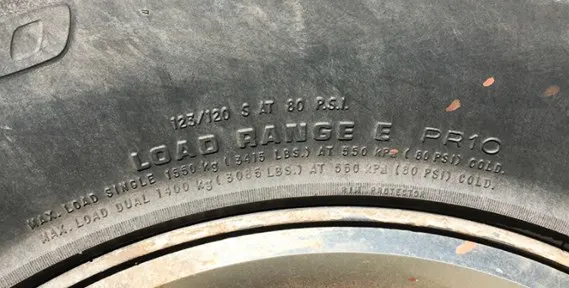
The load range is expressed as a letter at the tires’ sidewalls. Some letters descend the alphabetical order, eventually indicating the tire’s strength. However, there are few exceptions in the load range.
Other than those exceptions, almost all the tires fall in the D-F load range. Below is a table indicating which content would bear how much weight in terms of numbers.
- The B range would bear 4 PLY of weight.
- The C range would bear 6 PLY of weight
- The D range would bear 8 PLY of weight
- The E range would bear 10 PLY of weight
- The F range would bear 12 PLY of weight
Tire PLY Rating:
It is an expression of the strength and the capacity of load that a tire can bear. This capacity of strength and weight is known as the PLY rating of the tires.
It indicates the capability and limitations of the tire in a straightforward manner, especially when it comes to terms of air inflation in tires or in situations where one wishes to tow or haul another vehicle alongside. In such moments, the PLY capacity of the tires is to be kept in mind strictly.
1. M+S Rating:
This rating is not unique. This rating has been determined by the Rubber Manufacturer’s Association, which indicates that all these tires are M+S, which means these are Mud and Snow rated. It means they possess increased traction, which would eventually help the vehicle maneuver in rough terrains.
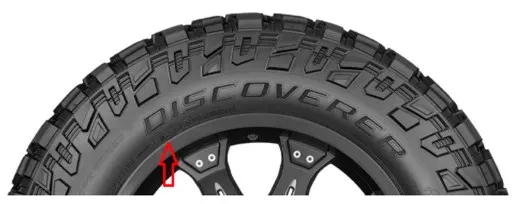
2. Sidewall Tread Blocks:
The tires which are off-road capable have a unique characteristic property. That unique property is that these tires have extended tread patterns towards their sidewalls.
So this characteristic of off-road tires happens to be the most prominent one. If a tire has extended tread patterns over its sidewalls, that would mean those tires are mud tires capable of off-roading.
| Tire type and width | Width is the widest point of tire from the sidewall to sidewall. Some of the tires have P or LT indicated on the front of the tire width. It helps to identify them for passenger or light truck use. |
| Radial construction and aspect ratio | Aspect ratio is the dimensional relationship in between the section height to width. R on the tires indicate radial tire construction. |
| Speed symbol, diameter and load index | Load index number and speed symbol are maximum load-carrying capacity of tire and maximum speed capability. Diameter is the size of wheel from one side to another. |
| DOT tire ID number | DOT tire is an identification number with all sorts of safety standards mentioned. It is established by U.S department of transportation and provides additional information. |
| Traction, tread-wear and temperature grades | The UTQG code mentioned on tires provides information regarding tread-wear, traction and operating temperature resistance. |
| Mud, snow and severe snow tires | The M+S seen on tires indicates mud and snow tire. These tires are designed for severe snow conditions. |
Understanding the Size of the Mud Tires:
If a person needs to understand what the numbers integrated at the sidewalls of the tire mean, they should memorize what those digits and alphabets stand for. Below is an example that would make it easy for people to remember how to understand the size of an off-road tire.
1. The First Number at the Sidewall:
The first number integrated at the tire’s sidewall represents the tire’s diameter in inches.
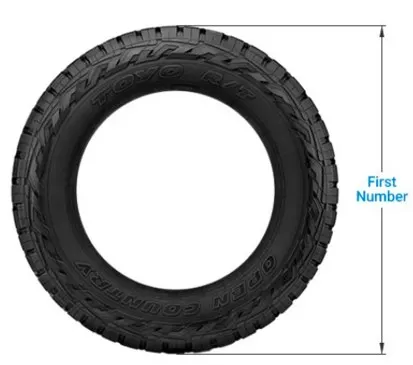
2. The Second Number at the Sidewall:
The second number integrated at the sidewall of the tire represents the tire’s width, which is also expressed in inches.
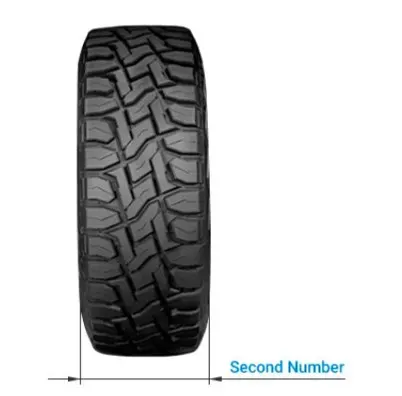
3. The Third Number at the Sidewall:
The third number, which is integrated at the tire’s sidewall, is unchanged, which means that the third number is similar to the standard number of the tire. The third number elaborates the size of the tire’s rim, which is also expressed in terms of inches.
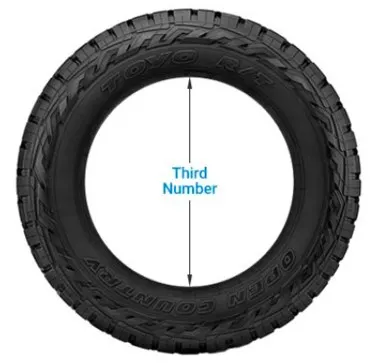
Also Read:
How to Read ATV Tire Size? The Complete Guide
Why are Mud Tires Loud? All You Need to Know
Frequently Asked Questions(FAQs):
How can you read a 35-inch tire size?
35-Inch tire size can be scanned through the tire reading process. Thirty-five inches indicates the tire’s diameter. After diameter, the following number is the tire’s width, followed by radial tire indication.
What is meant by 12.50 on a tire?
12.50 is usually the section width mentioned in inches. At the same time, the R represents the radial section on the tire and the width section.
Are the 285 tires the same as 33?
285 tire has a diameter of 32.82 inches, and the actual diameter is different from one manufacturer to another in the industry.
Are the 305 tires the same as 33?
305/55r20 tires can sometimes be the same as 33-by-12.5 or might be not. Sometimes, they are smaller than the 33-inches tire, as some manufacturers vary.
Are 315 tires considered the same as 35-inch size tires?
315 tires are wider but are the same as 35-inches tires. 315 is the tread width mentioned in millimeters, while 35-inches is the tire’s diameter.
What do you mean by It285 75R16?
285 in this example indicates that the tire has a width of 285 millimeters. 75 means that the aspect ratio of tires is 75%, or we can say that the tire’s sidewall height is 75% of its width.
What do you mean by LT on a tire?
If you observe the word LT on the tire size, the tire is made up for light truck use. Such tires are made for light-duty purposes, especially for SUVs and vans.
How can you read tire sizes?
Tire size is not so complicated to read. The slash mentioned after the tire size indicates aspect ratio; for instance, we can take an example of P215/65 R15 tire. Here, 65 means height equals 65% of the tire’s width. According to the more significant aspect ratio, the tire’s sidewall will be bigger.
What do you mean by 50r on a tire?
50r is considered a two-figure aspect ratio, and it is the percentage that compares the section height of the tire with the section width of the tire. In an example, 50 mentioned on the tire means that the tire’s section height is 50% of the tire’s section width.
What is meant by XL mentioned on tires?
XL means the extra load on tires. It does not mean that they are extra-large. It means that they can bear the additional burden. The load index on such tires is higher than a standard-load tire.
What do you mean by M's mentioned on a tire?
If you see a said indicator as M+S, it means that the tire has met the guidelines of the rubber manufacturers association for mud and snow.
Do LT tires also ride rough?
LT tires are build-up for heavy vehicles, and their stiffness provides a harsh ride to cars. These tires offer higher tire pressure even to throw off the vehicle.
Are the LT tires bigger than the P tires?
The word “P” mentioned on the tire size indicates “P-metric size.” The cords associated with LT tires are larger gauge than the P=metric tires. It is done so that the tires can carry heavy loads. LT tires have an extra steel belt and thick rubber in the sidewall for additional protection.

This is Surya. I am an experienced off-roader. I have been off-roading for many years across several terrains. I am passionate about 4×4 driving and want to share my knowledge and experience with others.
My goal is to provide you with the most comprehensive and unbiased information about off-roading.
I curated this article through my personal experience and expertise, and I hope it helps you with what you are looking for.

 (+91)9123743026
(+91)9123743026
 24/1 Nibedita Sarani. M.B. Road, Kolkata- 700051, India
24/1 Nibedita Sarani. M.B. Road, Kolkata- 700051, India